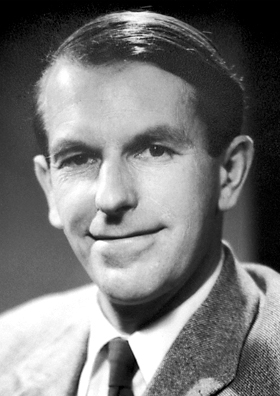Albert Einstein only won one Nobel Prize. Marie Curie won two, first in Physics and then Chemistry. Only one person has ever been awarded two Nobel Prizes for Chemistry, the English biochemist, Fred Sanger. Yet, his contribution to genomics, the modern term for his area of research, is not widely known. There is not even a comprehensive and accessible account of his life. Could it be that his background and character are responsible both for the double prize and his lack of fame?
Childhood
Fred Sanger was born in Gloucestershire, England in August 1918, just before the First World War ended. His father was a GP who married a wealthy woman who happened to be one of his patients. Fred had a brother one year older than him and a younger sister. The three Sanger children were brought up as Quakers. At the age of nine, Fred was sent to boarding school. He was a quiet and quite shy child but after a period of homesickness he doesn’t seemed to have minded being away from his family for much of the year.
Fred was a good student with a particular liking for chemistry and biology but was not very strong at mathematics. He liked doing things with his hands and learned carpentry and how to weld metals. He was modest and not very confident of his own abilities, doing better in his end of school exams than he expected. He gained a place at St Johns College, Cambridge University in 1936. His father expected him to study medicine, but Fred, perhaps remembering the long hours his father spent caring for his patients, decided to do natural sciences. In the first part of his degree he studied mainly chemistry and physics but found the mathematical aspects of physics difficult. He swapped physics for physiology. For the last stage of his degree he chose to study biochemistry. Biochemistry is the investigation of the substances and chemical reactions responsible for the processes of life in cells. In the 1930s it was a relatively new science and at Cambridge University it was led by Frederick Gowland Hopkins the discoverer of the substances that act as vitamins.
End of Youth
During his period as a student, both Fred’s parents died of cancer and the 2nd World War began. As he was over 18 at the outbreak of the war, Fred was likely to be “called-up” to join the armed services. Fred was however a Quaker, a member of the Cambridge University anti-war movement and he had signed the Peace Pledge stating that he would not fight. His future wife, Joan was also a student and a pacifist. He applied to be a conscientious objector and was called to face a tribunal to give his reasons.
The Quakers are a Christian religious group that formed in the mid-seventeenth century. They rejected the structure of the Church of England and Catholic Church with their priests and bishops and flamboyant church services. Quakers met in quiet contemplation, vowed to care for each other and refused to fight. Although persecuted at first, some Quakers established businesses that were very influential in the nineteenth and twentieth century. By the twentieth century their pacifism was respected.
Sanger’s application to the tribunal was accepted. While many conscientious objectors were made to do various types of manual work rather than join the fighting, Sanger was allowed to complete his degree in biochemistry. He didn’t make any plans for what to do next but was surprised when he achieved a First Class degree. This persuaded him to study for a PhD., a doctorate, at Cambridge. As he had inherited quite a lot of money from his parents he did not need a grant or sponsorship to begin his research. He just needed a supervisor.
Protein sequencing
An important topic for biochemical research was the study of proteins and the amino acids that they are composed of. After a false start, Fred joined the laboratory of Albert Neuberger to investigate what happens to the amino acid, lysine, when it is digested. Fred and Joan married in December 1940 soon after he started work.
Fred’s PhD. thesis didn’t really solve the problem he’d been set and his poor spelling nearly got it rejected by the examiners. He had however shown himself to be an excellent experimental chemist and he had learned lots of useful practical techniques. Fred was awarded his doctorate and given a new task, to work out the sequence of amino acids that make up the vital protein insulin.
In the 1930s, there was a lot of confusion about proteins. It was known that they were vital to the processes of life. Some scientists thought that genes were somehow carried by proteins. The structure of proteins was a mystery and some people thought that they were just a mixture of amino acids. By the 1940s some scientists were starting to use X-ray crystallography to determine the shape of protein molecules, but it was a very slow job.
For ten years from 1944, Fred Sanger slowly developed the techniques for splitting protein chains, separating the fragments and identifying the order in which the amino acids linked together. To do this he used new methods of chromatography and of tagging bits of the protein with particular reagents and radioactive isotopes. In 1954 he had the sequence of the fifty-one amino acids in the two chains that are linked together in insulin. Fred’s methods could be used for other proteins and biochemists gratefully copied his work. This was the main reason why Fred was awarded the Nobel Prize for Chemistry in 1958.
Sequencing the genome
By the time they receive their award many Nobel Prize winners have moved out of the laboratory. They are professors running departments with research teams and teaching programmes. Nobel prize winners become public figures and their opinions are sought on many and varied questions.
Fred Sanger was a little different. He was not a lecturer and being quiet and modest was not keen on fame or in becoming a manager. At the age of 40 all he wanted to do was continue his work in his laboratory with his assistants, research students and colleagues.
Following his work on proteins, Sanger turned to the nucleic acids, RNA and DNA. By the 1950s it had been realised that it was DNA that carried the genes. In 1953 Crick, Watson, Wilkins and Franklin showed that the two strands in DNA formed a double helix in which the order of the bases, or nucleotides, provided a code for genes. Soon the basic mechanism had been worked out by which different types of RNA molecule read the DNA code and assemble amino acids into proteins or copy the DNA chain itself. Sanger set out to find the sequence of bases on first RNA and then DNA. He used similar methods to his earlier work but had to find new chemical reactions for splitting the RNA and DNA chains and for identifying the fragments and the order of the bases.
In 1962, Sanger and his colleagues moved out of the centre of Cambridge to the new Laboratory of Molecular Biology. This building was devoted to research and Sanger’s Nobel Prize was one factor in getting the money for the project. By now Sanger had a sizeable team working on different aspects of the problem. Most leaders supplied their names to any papers their team produced. Sanger was different. He would only add his name if he felt he had made a significant contribution to the experimental lab-work. He and his fellow scientists worked long hours. He would start at 9:30 a.m. and work into the evening and at weekends. However, he always took two hours off for lunch when he went home to be with his wife, Joan. Often there were informal evening meetings where scientists at all stages in their careers discussed their work and the problems they were having. Two of Sanger’s closest collaborators, Bart Barrell and Alan Coulson, had joined him straight from school or college and didn’t have degrees. They were his technicians who worked alongside him in the laboratory.
By 1977, Sanger’s methods had succeeded in working out the sequence of over five thousand bases in the DNA of a virus. They went on to sequence the sixteen thousand bases in the DNA found in the mitochondria, the power stations of the cell. The methods had been developed to tackle the 3 billion bases in human DNA.
In 1980 Fred Sanger was awarded his second Nobel medal, with a one-third share of the prize. His work became the basis of the Human Genome Project which achieved its aim in 2000. Much of the work took place in the Sanger Centre built on the outskirts of Cambridge in 1992. Fred however had retired in 1983 and spent the remaining thirty years of his life gardening, boating, reading and entertaining his grandchildren. He died in 2013. He described himself as “just a chap who messed about in a lab” and “academically not brilliant”.
Activities
1 What use do you think learning skills in carpentry and welding as a teenager were to Fred Sanger?
2 Sanger’s struggles with Maths and Physics delayed the completion of his degree. What effect do you think this had on his career?
3 Many conscientious objectors in the 2nd World War were despised and shunned by other people. Why did this not happen to Fred Sanger?
4 Chromatography formed an essential part of Sanger’s research. Find out about the development of methods of chromatography. (See the work of Archer John Paul Martin and R.L.M. Synge.)
5 You may have done experiments on the paper chromatography of coloured dyes e.g. in grass. The substances that Sanger was separating were colourless. How did he “see” the results?
6 Once Sanger had determined the sequence of amino acids in insulin it became possible to manufacture it artificially. Why was this important?
7 Sanger said that achieving his second Nobel Prize was easier than his first. Why do you think this was the case?
8 Why do you think Sanger is the only person to win two Nobel Prizes for Chemistry?
9 Sanger’s DNA sequencing that brought him his second prize became the basis of the Human Genome Project. What did the HGP do and what benefits was it supposed to bring?
10 There have been many books, films and TV programmes about Einstein, Curie, Crick and Watson, but little about Fred Sanger. Why is this?
11 Sanger said that his success was partly from “being at the right place at the right time”. Was he correct or being over-modest?
Bibliography
1 Fred Sanger Double Nobel Laureate: A Biography, George G. Brownlee, pub. CUP 2014
2 Oxford Dictionary of Scientists. pub. OUP
3 https://en.wikipedia.org/wiki/Frederick_Sanger
4 https://www.nobelprize.org/nobel_prizes/chemistry/laureates/1958/
5 https://www.nobelprize.org/nobel_prizes/chemistry/laureates/1980/
6 https://en.wikipedia.org/wiki/Conscription_in_the_United_Kingdom#Second_World_War
7 https://en.wikipedia.org/wiki/Quakers
By Peter Ellis
Image copyright
Nobelprize.org [Public domain], via Wikimedia Commons



